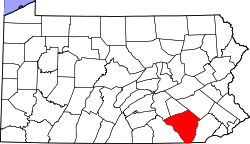Conestoga Township, Lancaster County, Pennsylvania
| Conestoga Township, Pennsylvania | |
|---|---|
| Township | |
|
Grubb Run within Shenks Ferry Wildflower Preserve in the township | |
 Map of Lancaster County, Pennsylvania highlighting Conestoga Township | |
 Map of Lancaster County, Pennsylvania | |
| Country | United States |
| State | Pennsylvania |
| County | Lancaster |
| Settled | 1759 |
| Incorporated | 1712 |
| Government | |
| • Type | Board of Supervisors |
| • Chairman | Craig C. Eshleman |
| • Vice Chairman | Robert A. Funk |
| • Member | Steven R. Charles, Sr. |
| Area | |
| • Total | 16.4 sq mi (42 km2) |
| • Land | 14.6 sq mi (38 km2) |
| • Water | 1.8 sq mi (5 km2) |
| Population (2000) | |
| • Total | 3,749 |
| • Density | 256.3/sq mi (99.0/km2) |
| Time zone | Eastern (EST) (UTC-5) |
| • Summer (DST) | EDT (UTC-4) |
| Area code(s) | 717 |
| Website | Conestoga Township |
Conestoga Township is a township in west central Lancaster County, Pennsylvania, United States. At the 2000 census the population was 3,749.
History
Conestoga Township was formed in 1712 as part of Chester County. Lancaster County was not formed until 1729. Pequea Township was formed from Conestoga Township.[1]
Conestoga wagons are named for the township, but it cannot be proven that the first such wagons were built in the township. But these wagons were indeed built in Conestoga Township.[1]
| Historical population | |||
|---|---|---|---|
| Census | Pop. | %± | |
| 1980 | 3,032 | — | |
| 1990 | 3,470 | 14.4% | |
| 2000 | 3,749 | 8.0% | |
| Est. 2005 | 3,797 | ||
The Colemanville Covered Bridge and Big and Little Indian Rock Petroglyphs are listed on the National Register of Historic Places.[2]
Geography
According to the U.S. Census Bureau, the township has a total area of 16.4 square miles (42 km2), of which, 14.6 square miles (38 km2) of it is land and 1.8 square miles (4.7 km2) of it (11.02%) is water.
Demographics
As of the census[3] of 2000, there were 3,749 people, 1,374 households, and 1,067 families residing in the township. The population density was 256.3 people per square mile (99.0/km²). There were 1,409 housing units at an average density of 96.3/sq mi (37.2/km²). The racial makeup of the township was 98.32% White, 0.32% Black or African American, 0.13% Native American, 0.16% Asian, 0.21% Pacific Islander, 0.13% from other races, and 0.72% from two or more races. 0.99% of the population were Hispanic or Latino of any race.
There were 1,374 households, out of which 36.0% had children under the age of 18 living with them, 66.2% were married couples living together, 7.5% had a female householder with no husband present, and 22.3% were non-families. 17.3% of all households were made up of individuals, and 5.7% had someone living alone who was 65 years of age or older. The average household size was 2.73 and the average family size was 3.10.
In the township the population was spread out, with 26.9% under the age of 18, 7.4% from 18 to 24, 29.5% from 25 to 44, 26.3% from 45 to 64, and 9.9% who were 65 years of age or older. The median age was 38 years. For every 100 females there were 101.9 males. For every 100 females age 18 and over, there were 102.0 males.
The median income for a household in the township was $51,895, and the median income for a family was $57,768. Males had a median income of $37,284 versus $25,956 for females. The per capita income for the township was $21,939. About 2.2% of families and 3.5% of the population were below the poverty line, including 2.2% of those under age 18 and 2.9% of those age 65 or over.
References
- 1 2 "Township History". County of Lancaster, Pennsylvania. Retrieved 2008-05-20.
- ↑ National Park Service (2010-07-09). "National Register Information System". National Register of Historic Places. National Park Service.
- ↑ "American FactFinder". United States Census Bureau. Archived from the original on 2013-09-11. Retrieved 2008-01-31.
Coordinates: 39°55′00″N 76°22′59″W / 39.91667°N 76.38306°W
.jpg)